DMX512 (Digital Multiplex) is a standard for digital communication networks that are commonly used to control stage lighting and effects. It was originally intended as a standardized method for controlling light dimmers up to 512 dimming channels. The first standard version was created in 1986, with subsequent revisions in 1990 leading to USITT DMX512/1990, ANSI standard in 2004 and revision in 2008 known as “E1.11 – 2008, USITT DMX512-A”, or just “DMX512-A”.
It soon became the primary method for linking controllers (such as a lighting console) to dimmers and special effects devices such as fog machines and intelligent lights. DMX has also expanded to uses in non-theatrical interior and architectural lighting, at scales ranging from strings of Christmas lights to electronic billboards.
A DMX512 network employs a multi-drop bus topology where devices are typically daisy chained after each other. A network consists of a single DMX512 controller – which is the master of the network — and one or more slave devices. DMX512 uses unidirectional variable-size packet-based communication protocol. At the datalink layer, a DMX512 controller transmits asynchronous serial data at 250 kbit/s. DMX512′s popularity is partly due to its robustness.DMX512 data is transmitted over a differential pair using EIA-485 voltage levels on cable with nominal characteristic impedance of 120 ohms. DMX512 does not include automatic error checking and correction, but due to cyclic constant transmission of all data errors due the interference are short temporary problems (just slight light flicker of noticeable at all).
The original DMX512 1990 specified that where connectors are used, the data link shall use five-pin XLR style electrical connectors (XLR-5). DMX512-A (ANSI E1.11-2008) defined the use of eight-pin modular (8P8C, or “RJ-45″) connectors for fixed installations. However three-pin XLR connector is commonly used for DMX512, on lighting and related control equipment, particularly at the budget/DJ end of the market (although that is specifically prohibited by section 7.1.2 of the DMX512 standard).
There is lots of information and project related to DMX512 in Internet. DMX-512 page from Ujjal website has been helping thousands of folks in understanding DMX512 since 1996.
There are some interesting open hardware projects on DMX512. Maybe the most popular is OpenDMX that is DMX512 master interface for PC. The Open DMX USB is inexpensive way to get into the world of controlling DMX devices from a PC. You can buy it as a ready made product or you can build one yourself. It is supported by many control software. It provides no-fuss control of 512 channels with full compatibility with a range of programs.Using a simple application on a PC you can send and also receive DMX512. It is very suitable for example for small live music applications.
Open DMX USB is an open USB to DMX hardware design developed by Enttec. The Open in Open DMX USB refers to the fact that everybody is free to use the design and produce its own USB DMX dongle without paying any licenses.This DMX USB interface is based on the FTDI 232RL chip, that a USB to serial converter. Basically the interface consists of FTDI 232RL chip and RS-485 transceiver chip. This interface design relies on the computer to handle all the timing of the DMX signal.
Here is my version of Open DMX USB design. I have built this many years ago and it has served me well.
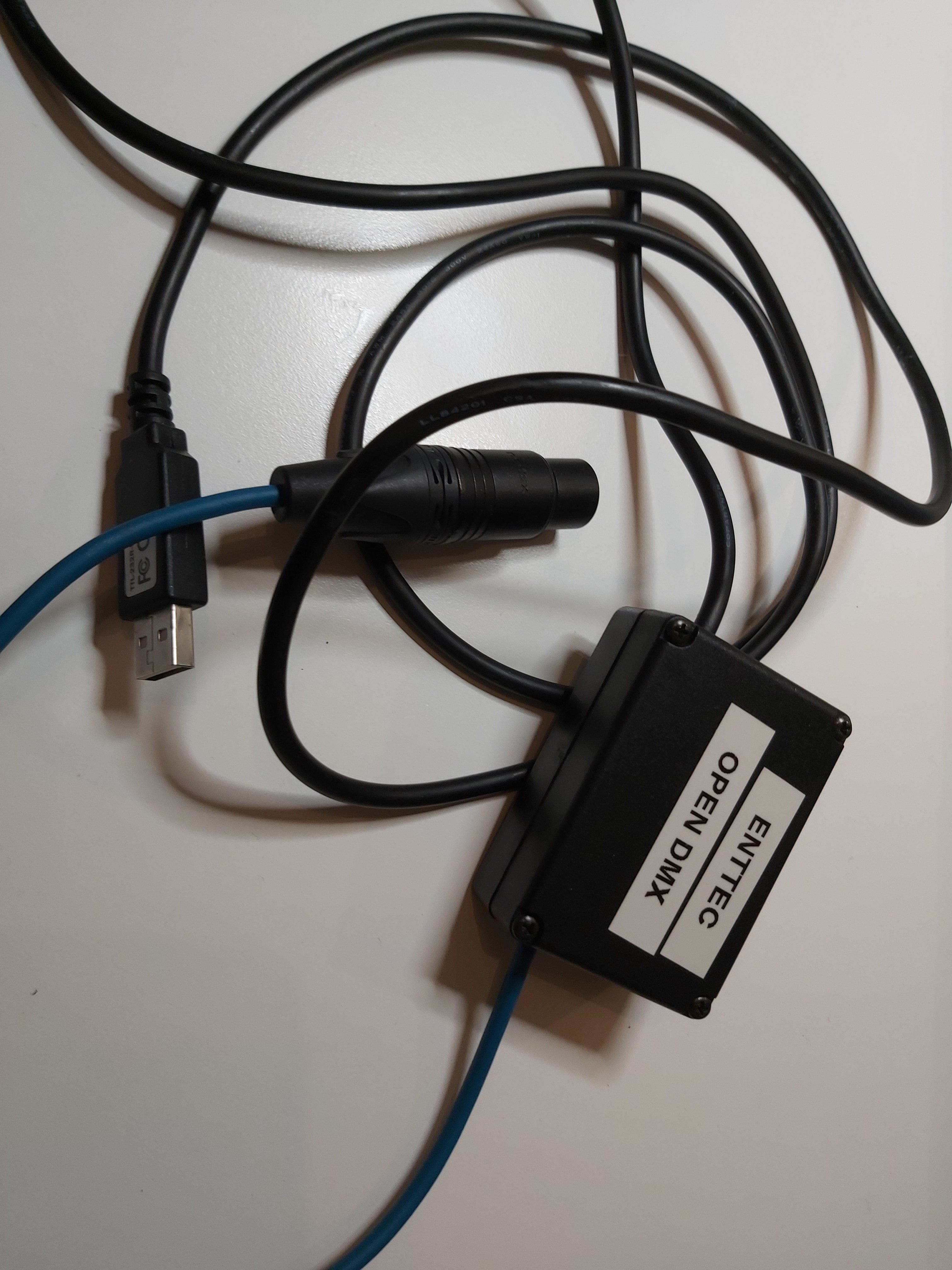
Closer look to the electronics box.
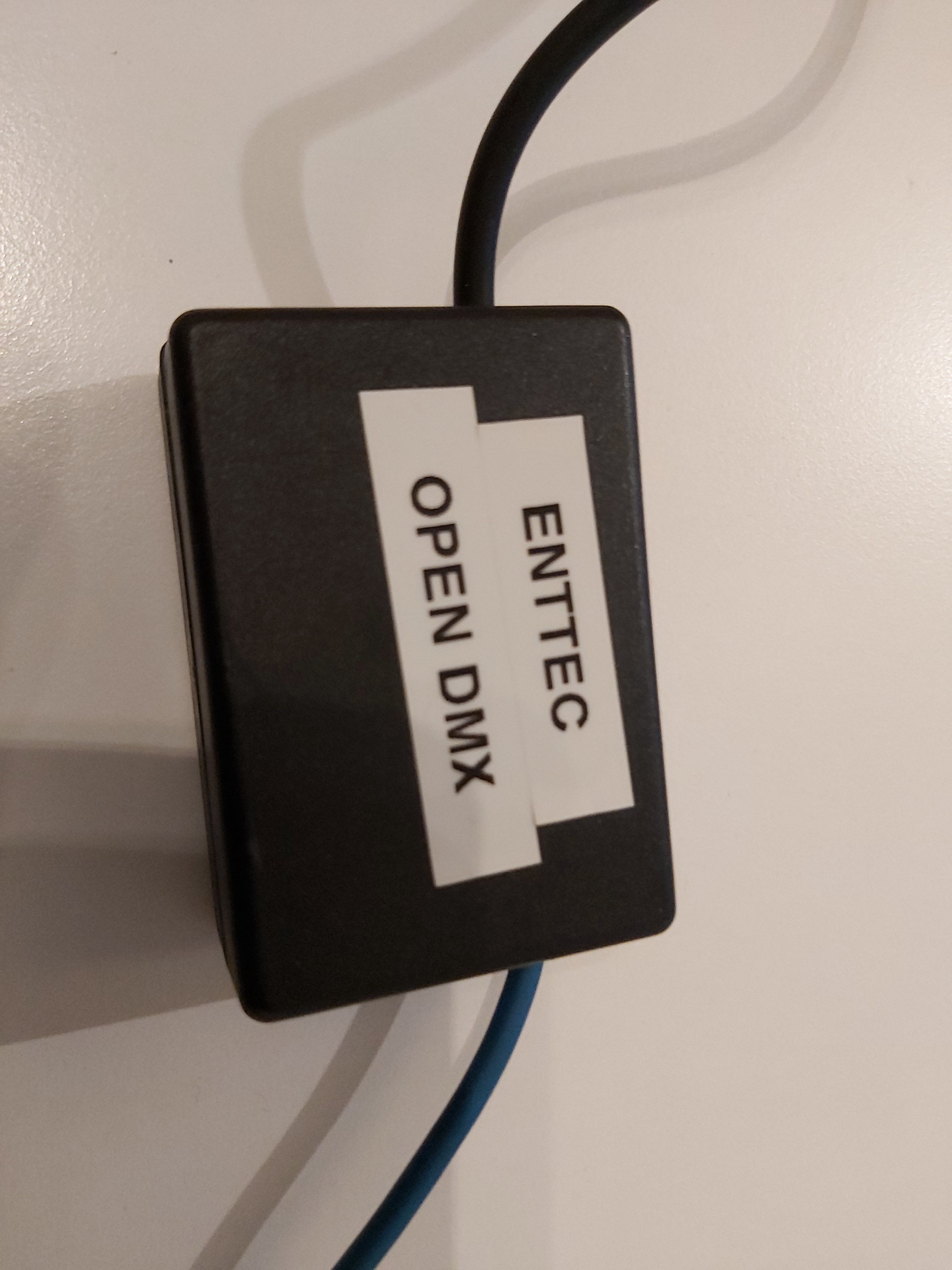
Let’s look inside.
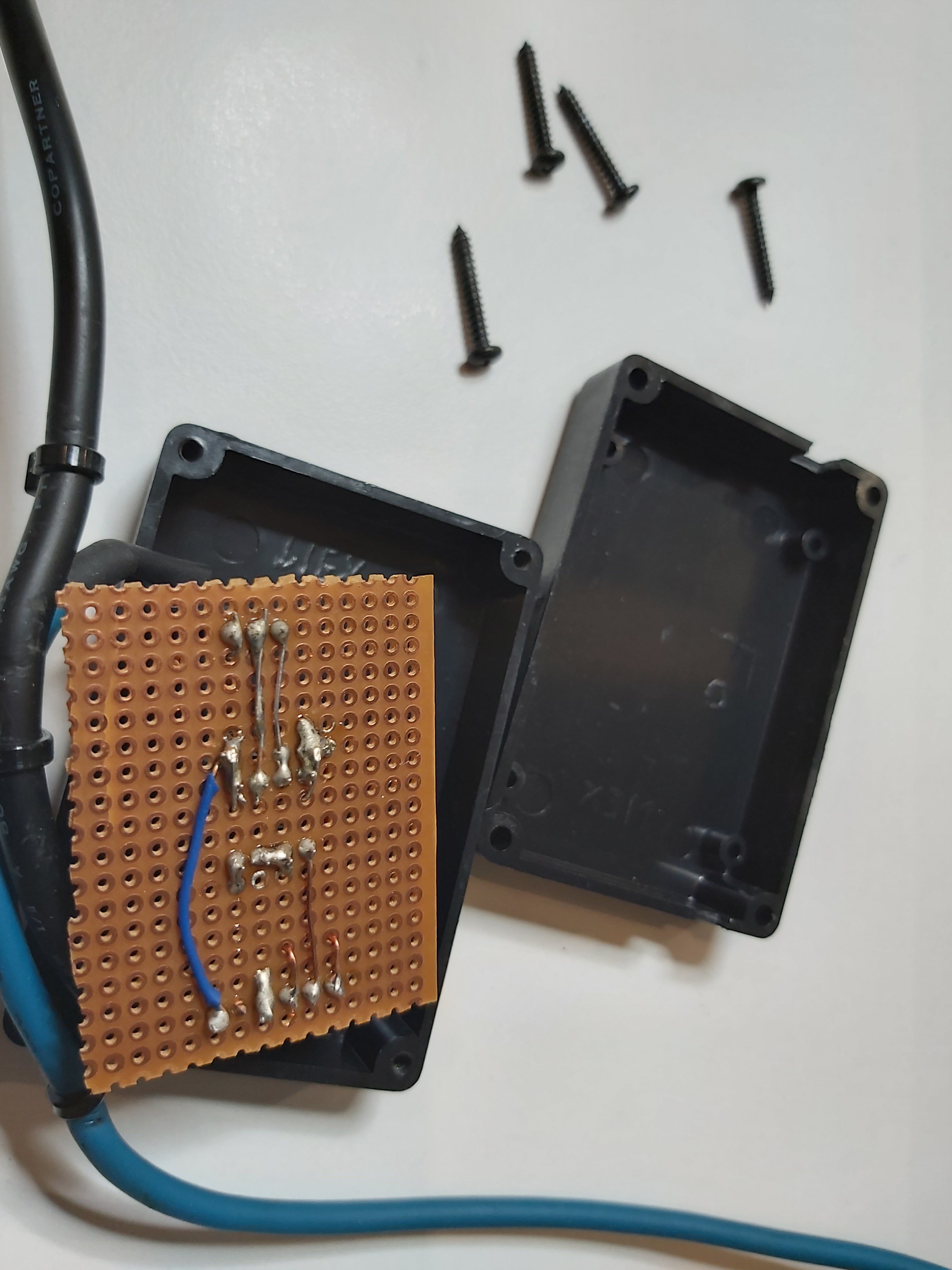
The circuit is built to a small piece of the prototyping board that host only the RS-485 transceiver chip. The USB-serial conversion part is handled by FTDI TTL-232R-5.0V USB- TTL Serial Cable based on FTDI 232RL chip, so all I had to add to it was MX483 chip that converts the serial data top RS-485. I also added few resistor to provide proper RS-485 line termination.
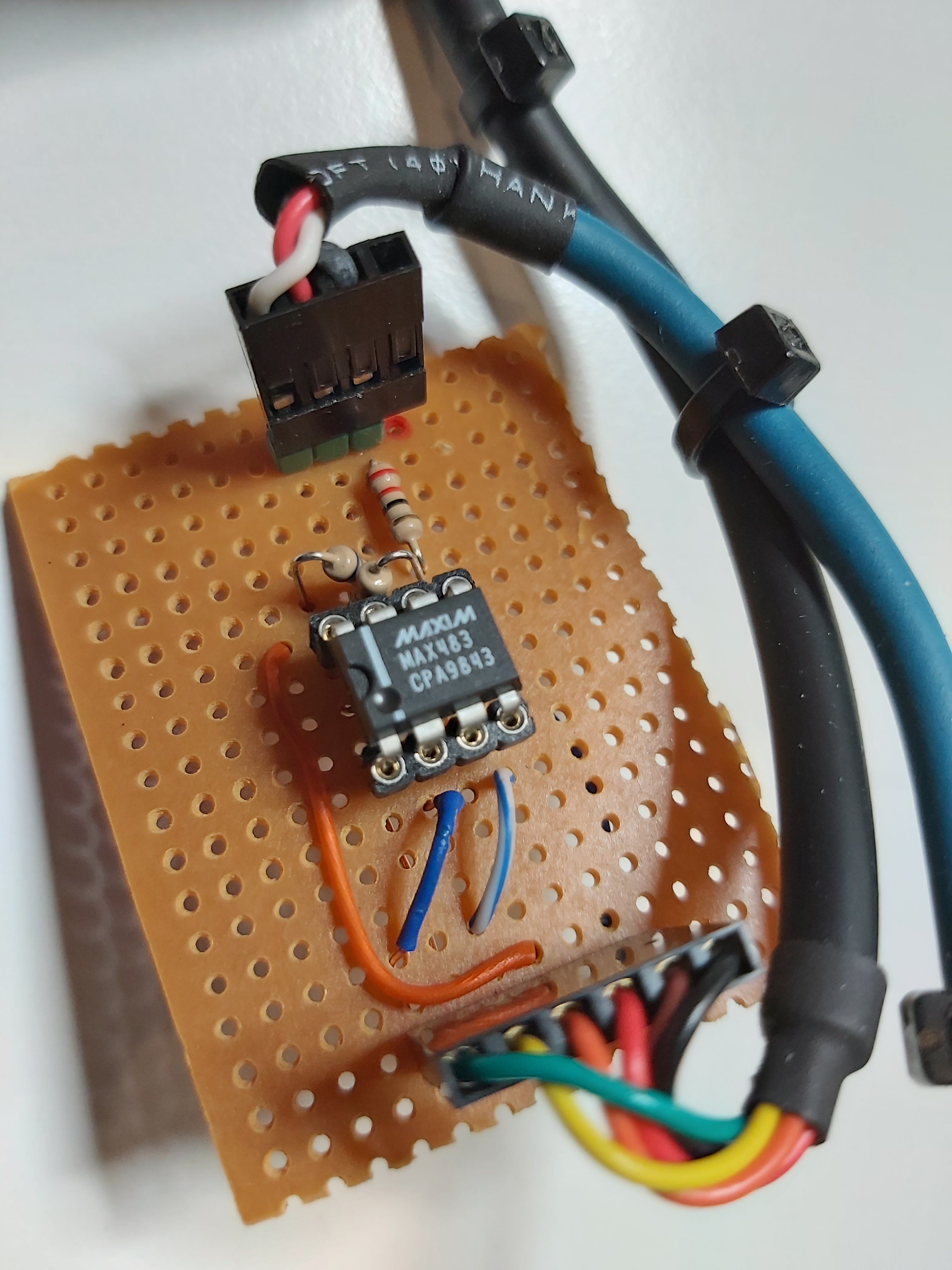
Other angle view.
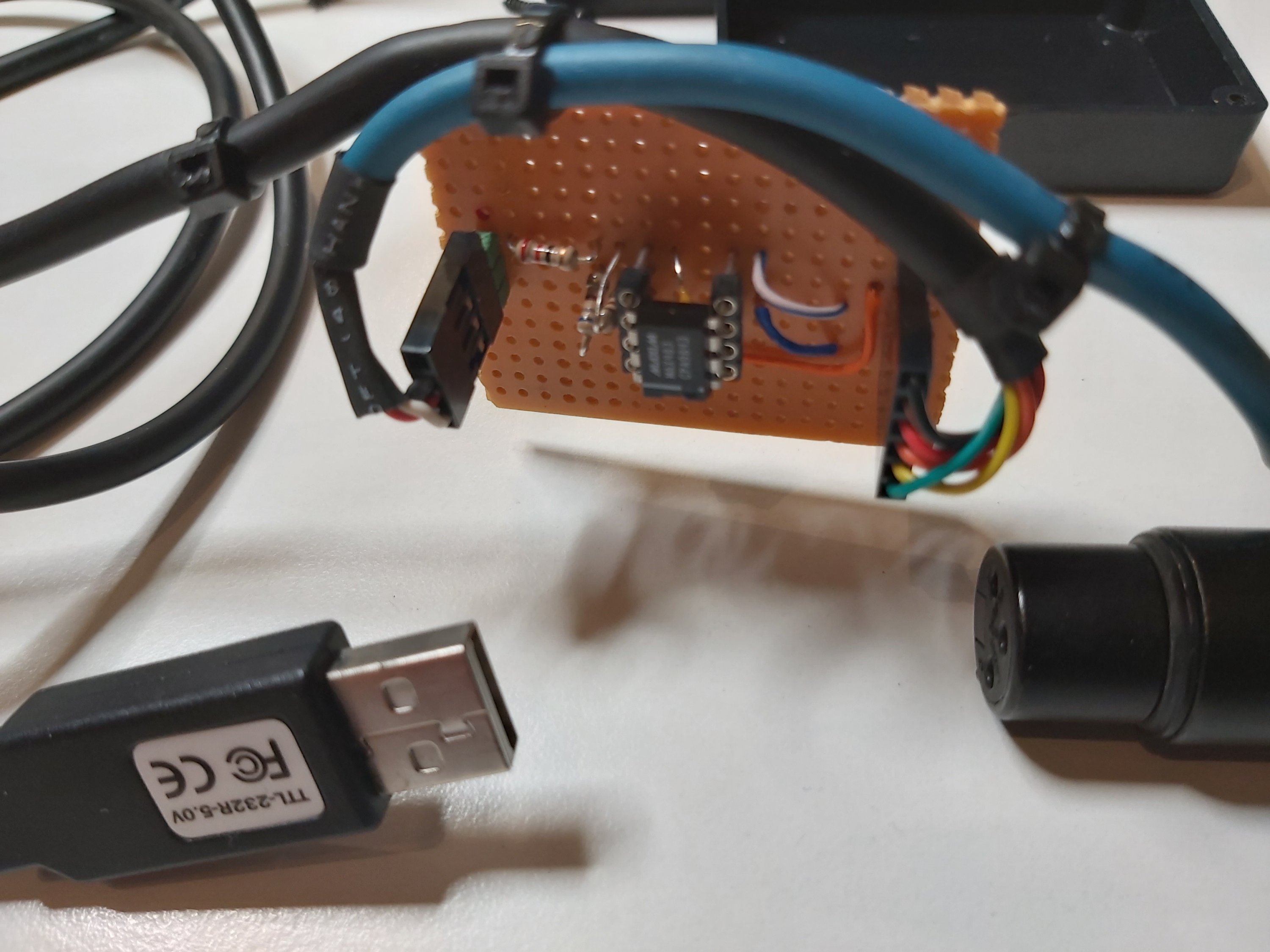
I have not drawn specific circuit diagram, but this OpenDMX Compatible Unbuffered USB-DMX Interface project page has a good circuit diagram showing what is inside this circuit:
Links to more information:
https://www.enttec.co.uk/en/product/controls/dmx-usb-interfaces/open-dmx-usb/
https://sourceforge.net/projects/opendmxusb/
https://vvvv.org/contribution/opendmx-(devices-enttec)
Other HW projects:
OpenDMX Compatible Unbuffered USB-DMX Interface project
Your Arduino becomes a OpenDmx USB interface is a tutorial that explains how to use the Arduino as a USB to DMX interface for software that works with OpenDmx. Not that this design works only with an old arduino board that used FTDI chip, and the new Arduino UNO that uses different USB-serial chip (that is not compatible with this application)
DIY USB DMX Interface for under 10$ page describes how to convert a cheap RS485 USB converter to control DMX devices. Some cheap adapters can be used directly, some need some small modifications and some can’t be used. Be sure to get a converter that uses original FTDI chip and not any clones or completely different chips.
Links to software I have used:
QLC+ is a free and cross-platform software to control DMX or analog lighting systems like moving heads, dimmers, scanners etc. QLC+ runs on Windows, MacOS and Linux.
FreeStyler DMX is a free lighting control software used by many dj’s, venues and lighting designers. It can be used together with “Magic 3D easy view” visualizer for FREE.
Other interesting looking links:
https://github.com/paulhayes/UnityOpenDMX
https://github.com/orcaomar/processing-opendmx
https://wiki.openlighting.org/index.php/Open_Lighting_Project
https://wiki.openlighting.org/index.php/Open_Lighting_Architecture
https://stackoverflow.com/questions/15732608/how-to-control-enttec-open-dmx-usb-via-python
https://github.com/davepaul0/DmxPy

15 Comments
Tomi Engdahl says:
DMX-Examples
A collection of DMX512 examples
https://tigoe.github.io/DMX-Examples/arduinodmx.html
Tomi Engdahl says:
https://controlgeek.net/blog/2020/8/20/rdmnet
Tomi Engdahl says:
Designed for use with ESP8266 or NodeMCU modules, this board provides full control over two DMX universes.
Inpublic Space’s New ESP8266, NodeMCU Board Provides Control Over Two DMX Universes
https://www.hackster.io/news/inpublic-space-s-new-esp8266-nodemcu-board-provides-control-over-two-dmx-universes-8153f524e9fa
Designed for use with ESP8266 or NodeMCU modules, the board provides full control over two DMX universes.
Tomi Engdahl says:
http://joat-mos.blogspot.com/2014/01/repairing-dmx-lighting-controller.html?m=1
Tomi Engdahl says:
Learn DMX512 Basics
https://hackaday.com/2021/10/15/learn-dmx512-basics/
If you’ve done anything with modern lighting effects, you’ve probably heard of DMX, also known as DMX512. Ever wonder what’s really happening under the hood? If so, then you should have a look at [EEForEveryone’s] video on the topic, which you can see below.
At the core, the DMX512 uses RS485, but adds software layers and features. The video uses the OSI model to show how the system works.
Of course, RS485 is just a physical layer like a serial port. The DMX standard defines an actual protocol.
DMX512 Overview – RS485, Differential Signals, and Addressing | DMX 2
https://www.youtube.com/watch?v=SsDJyOMiliA
Tomi Engdahl says:
Maybe this type of cable could already implement what I have done (not verified in practice that works):
FTDI USB-UART RS485 KAAPELI +3,3V
Tuotekoodi: USB-RS485-WE-1800-BT
https://www.partco.fi/fi/tietokonetarvikkeet/vaeylaet/usb/usb-lisaelaitteet/23641-usb-rs485-we-1800-bt.html
https://fi.rsdelivers.com/product/ftdi-chip/usb-rs485-we-1800-bt/ftdi-chip-usb-serial-cable-adapter/6877834?cm_mmc=FI-PPC-DS3A-_-google-_-DSA_FI_FI_CatchAll-_-CatchAll-_-DYNAMIC+SEARCH+ADS&matchtype=&dsa-19959388920&s_kwcid=AL!7457!3!516482805014!!!g!!&gclid=EAIaIQobChMI89O9iKKs9QIVE_hRCh0B7A9OEAAYAiAAEgISoPD_BwE&gclsrc=aw.ds
Tomi Engdahl says:
inside a cheap eBay 1 to 8 way DMX buffer.
https://www.youtube.com/watch?v=kq4nU–hUAI
I thought it would be worth looking in one of these units to see if it follows the rules for proper buffering of a DMX512 (one direction RS485) lighting network as used in the theatre and show industries.
It turns out that the circuitry is quite standard with a proper MAX485 receiver and 8 matching transmitters, but it’s also a bit odd in that the circuitry is clearly based on a fully isolated buffer, but with the isolation defeated by the use of a single power supply.
With an application like this I would recommend swapping the supplied power supply for one from a reputable supplier. That way you can choose one amply rated for the task, plus avoid any isolation issues that could cause data corruption or damage other devices on a network.
Tomi Engdahl says:
https://pinoutguide.com/Audio-Video-Hardware/dmx-512_pinout.shtml
https://pinoutguide.com/Audio-Video-Hardware/DMX512_RJ45_pinout.shtml
Tomi Engdahl says:
uDMX – tiny bus powered USB-DMX interface
https://www.anyma.ch/research/udmx/
Tomi Engdahl says:
https://www.illutzmination.de/udmxdriver.html?&L=1
Tomi Engdahl says:
https://www.qlcplus.org/
Why Choose QLC+?
Say goodbye to expensive consoles
With QLC+, creating spectacular lighting designs is easier than ever. Our software is designed to streamline and simplify the process of controlling DMX or analog lighting systems. Whether you’re a professional lighting designer, a DJ, or a hobbyist, QLC+ is the perfect tool to make your vision come to life.
Whether you’re on a laptop, tablet, or smartphone, this intuitive interface provides real-time access to your lighting controls without the need for specialized software. Designed with responsiveness and adaptability in mind, it ensures that users can swiftly adjust settings, activate scenes, or monitor lighting statuses on-the-go. It’s a testament to QLC+’s commitment to making lighting control more accessible and versatile for professionals and enthusiasts alike.
Tomi Engdahl says:
these dongles sitting on my desk, it’s only a universe out but for a budget solution tell me you need more than that. Cheap DIY hardware, open source software, learn how the protocol works on a shoestring budget before deciding on which mainstream ecosystem you wanna buy into: https://diyprojects.tech/2013/05/diy-usb-dmx-dongle-interface-for-under-10/
Tomi Engdahl says:
There is even an ANSI standard for DMX over CAT wiring https://pathway.acuitybrands.com/-/media/abl/pathway/files/resources/reference-guides/pathway-dmx-wiring-guide.pdf?forceBehavior=open
Tomi Engdahl says:
https://support.etcconnect.com/ETC/FAQ/DMX_Over_Cat5
Tomi Engdahl says:
https://interactive-online.com/resources/faq/dmx-512-connector-pinouts